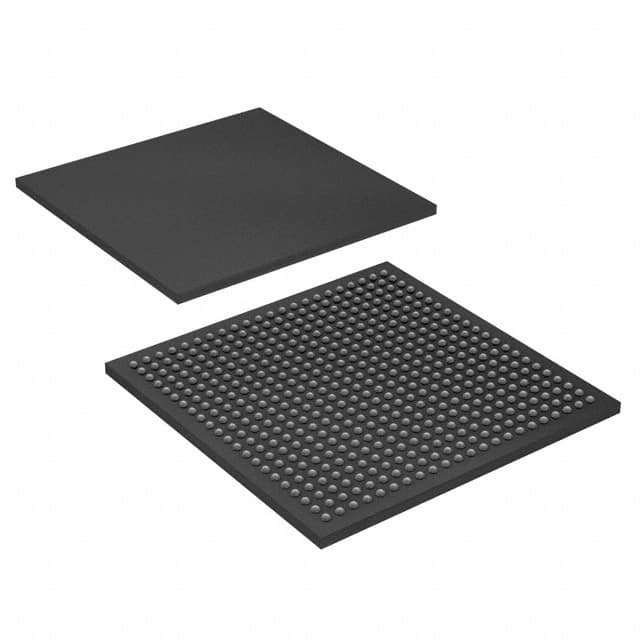EP3SL70F484I3N
Product Overview
- Category: Programmable Logic Device (PLD)
- Use: EP3SL70F484I3N is a high-performance PLD designed for various applications in the field of digital logic design and implementation.
- Characteristics:
- High-speed performance
- Large capacity
- Low power consumption
- Flexible configuration options
- Package: The EP3SL70F484I3N comes in a 484-pin FineLine BGA package.
- Essence: EP3SL70F484I3N is an advanced programmable logic device that enables designers to implement complex digital logic circuits efficiently.
Specifications
- Logic Elements: 70,000
- Embedded Memory: 1,536 Kbits
- User I/O Pins: 346
- Maximum Operating Frequency: 500 MHz
- Supply Voltage: 1.2V
- Operating Temperature Range: -40°C to 100°C
Detailed Pin Configuration
The EP3SL70F484I3N has a total of 484 pins, which are divided into different categories:
- Power Supply Pins: These pins provide the necessary voltage and ground connections for the device.
- Input/Output Pins: These pins are used to interface with external devices and connect to other components in the system.
- Configuration Pins: These pins are used to configure the device and load the desired logic design.
- Clock Pins: These pins provide clock signals for synchronous operation.
- Programming Pins: These pins are used for in-system programming and debugging purposes.
For a detailed pin configuration diagram, please refer to the datasheet provided by the manufacturer.
Functional Features
- High-Speed Performance: The EP3SL70F484I3N offers fast operating speeds, making it suitable for applications that require real-time processing.
- Large Capacity: With 70,000 logic elements and 1,536 Kbits of embedded memory, this PLD can handle complex designs.
- Low Power Consumption: The device is designed to minimize power consumption, making it suitable for battery-powered applications.
- Flexible Configuration Options: EP3SL70F484I3N supports various configuration modes, allowing designers to choose the most suitable option for their application.
Advantages and Disadvantages
Advantages: - High-performance capabilities - Large capacity for complex designs - Low power consumption - Flexible configuration options
Disadvantages: - Relatively high cost compared to simpler programmable logic devices - Steeper learning curve for inexperienced users
Working Principles
The EP3SL70F484I3N utilizes a combination of look-up tables (LUTs), flip-flops, and interconnect resources to implement digital logic functions. The device can be programmed using hardware description languages (HDL) or schematic entry tools. Once programmed, the PLD operates based on the configured logic design, processing input signals and generating output signals accordingly.
Detailed Application Field Plans
EP3SL70F484I3N finds applications in various fields, including:
- Telecommunications: Used in network routers, switches, and communication equipment for high-speed data processing.
- Industrial Automation: Employed in control systems, PLCs, and robotics for real-time control and monitoring.
- Automotive Electronics: Integrated into automotive systems for functions like engine control, driver assistance, and infotainment.
- Aerospace and Defense: Utilized in avionics, radar systems, and military-grade electronics for reliable and high-performance operation.
- Consumer Electronics: Incorporated into smart TVs, gaming consoles, and multimedia devices for enhanced functionality and performance.
Detailed and Complete Alternative Models
- EP3C40F484I7N: A lower-capacity alternative with 40,000 logic elements and 1,152 Kbits of embedded memory.
- EP3SE110F780I4N: A higher-capacity alternative with 110,000 logic elements and 2,816 Kbits of embedded memory.
- EP4CE115F29C7N: Another high-performance alternative with 115,000 logic elements and 2,816 Kbits of embedded memory.
These alternative models offer different capacity options to cater to various design requirements.
In conclusion, the EP3SL70F484I3N is a high-performance programmable logic device that provides designers with flexibility, large capacity, and low power consumption. Its applications span across multiple industries, and it has several alternative models available for different design needs.
Senaraikan 10 soalan dan jawapan biasa yang berkaitan dengan aplikasi EP3SL70F484I3N dalam penyelesaian teknikal
Sure! Here are 10 common questions and answers related to the application of EP3SL70F484I3N in technical solutions:
Q: What is EP3SL70F484I3N? A: EP3SL70F484I3N is a specific model of Field-Programmable Gate Array (FPGA) manufactured by Intel.
Q: What are the key features of EP3SL70F484I3N? A: EP3SL70F484I3N offers high-performance logic, embedded memory, digital signal processing (DSP) blocks, and various I/O interfaces.
Q: In which technical solutions can EP3SL70F484I3N be used? A: EP3SL70F484I3N can be used in a wide range of applications such as telecommunications, industrial automation, aerospace, and defense.
Q: How does EP3SL70F484I3N benefit technical solutions? A: EP3SL70F484I3N provides flexibility, reconfigurability, and high-speed processing capabilities, enabling efficient implementation of complex algorithms and designs.
Q: What programming languages can be used with EP3SL70F484I3N? A: EP3SL70F484I3N can be programmed using Hardware Description Languages (HDLs) like VHDL or Verilog.
Q: Can EP3SL70F484I3N interface with other components or devices? A: Yes, EP3SL70F484I3N supports various standard interfaces such as PCIe, Ethernet, USB, and SPI, allowing seamless integration with other components.
Q: Is EP3SL70F484I3N suitable for real-time applications? A: Yes, EP3SL70F484I3N offers low-latency and high-speed processing capabilities, making it suitable for real-time applications that require quick response times.
Q: Can EP3SL70F484I3N be used in safety-critical systems? A: Yes, EP3SL70F484I3N can be used in safety-critical systems as it supports features like error correction codes (ECC) and redundancy to ensure reliable operation.
Q: What development tools are available for programming EP3SL70F484I3N? A: Intel provides Quartus Prime software suite, which includes design entry, synthesis, simulation, and programming tools specifically for programming EP3SL70F484I3N.
Q: Where can I find additional resources or support for EP3SL70F484I3N? A: You can refer to the official Intel website for datasheets, application notes, user guides, and community forums dedicated to EP3SL70F484I3N. Additionally, Intel's technical support team can provide assistance if needed.
Please note that the specific details and answers may vary based on the context and requirements of your technical solution.


